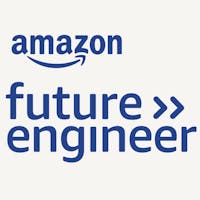One of the most common concerns in education, especially at the secondary level, is the need to connect students to careers. Many schools address this through career technical education, work-based learning and college/career counseling. Taking the idea one step further, some new programs are connecting students directly to employers, industry professionals and career mentors.
Amazon’s signature computer science program, Amazon Future Engineer, aims to broaden pathways for students to build careers, focusing especially on those who face systemic or economic barriers to education. Offering school curriculum, project-based learning and support for teachers, the program encourages students to begin exploring computer science in elementary school, equipping them with the skills needed for successful careers. And Class Chats—classroom visits during which Amazon employees share their personal career journeys with middle and high school students—allow learners to experience real professional opportunities.
Jacob Jun is a computer science teacher in the Salinas Unified School District and a 2020 recipient of the Amazon Future Engineer Teacher of the Year Award. We spoke with him recently to learn about his experience with the Amazon Future Engineer program and hear how Class Chats have impacted him and his students.
EdSurge: How did you learn about Class Chats?
Jun: I came from Cal Poly where our motto was, “Learn by doing.” I wanted to bring this to my classroom and students. My initial experience teaching IT and computer science led me to the Amazon Future Engineer program. The idea of connecting students to mentors, professionals and careers really spoke to me.
Amazon had me join the advisory group and asked me if I wanted to be involved in this unique program. Naturally, I agreed. The program provides multiple opportunities for my students to get engaged and connected to professionals, careers and their futures. This is about taking advantage of any and every opportunity. For example, field trips became almost impossible during the past 18 months, so Amazon helped us set up virtual field trips.
I like that Amazon is familiar to all of my students. They have instant credibility. They offer scholarships and even employment opportunities. My students, as well as their parents, appreciate these unique opportunities. Ultimately, this is all about opening doors.
How often do your students interact with tech professionals outside of this program? Is career exposure a concern for your students?
A few students will reach out to professionals on their own through social media and avenues such as LinkedIn. However, most will not. This needs to be facilitated by teachers, partners and industry professionals. I survey my students regularly. I ask them what I can do to help them with their learning, especially as it relates to their futures. They regularly ask for advice on how to get a job or get into a career.
They do have this concern, but they may not always articulate it. So, I work with them to develop the mindset that we all have to work to connect to our careers. The future can be scary for students and often hard to confront. It’s easier sometimes to avoid or delay. I work on showing them next steps or the ‘how’ if you will. I share my experiences as well, and they see that this is a process where things can eventually connect.
In what ways have your students benefited from Class Chats?
These chats are designed to engage the students. I have many students that are reluctant to talk or participate at times, but these chats seem to get everyone involved. One industry partner brought his entire team to meet with my students and then provided their emails and contact info for long-term mentoring and career development.
These chats were extremely vital this past year during distance learning. Some students were really locked down at home. They appreciated these connections and experiences more than ever. I always had 100 percent attendance on Class Chats days.
Experiences like this make students click or connect like they haven’t before. They become engaged in ways I didn’t anticipate. They often begin changing their whole approach to my class and school in general.
Class Chats are free, live, interactive and available to any school (grade 5+) at any geographic location. Amazon can structure a panel Class Chat with multiple employees for larger classes or schools (up to 3,000 participants) or an individual Class Chat for small classes with a single speaker. We also provide a complementary Teacher Toolkit to help create a career-focused lesson plan with worksheets, slides and activities to use before and after a Class Chat.
Teachers, learn more and sign up to request a Class Chat here.
Any challenges implementing this program in your classes?
I would say the technology piece. Something will always go wrong when you need it most. These are things that are usually out of our control. For me, it is addressing the fact that not everyone has the same infrastructure or access to high speed, consistent internet.
This is about equity and is a real challenge, especially for many of our rural communities. Collectively, we need to make access for all students an imperative. Zoom and other tools have shown us that we can meet, connect and often work more easily. Think about how industry partners don’t have to travel and give up so much time in order to support our students. This is the way forward to provide all students with these experiences. I think Amazon and programs like these are demonstrating how important these things are.
How has your experience with Amazon Future Engineer impacted your teaching? Would you encourage other teachers to get involved?
I think some educators are reluctant to involve corporations in their classrooms. All I know is that Amazon cares about education, and they have been really supportive of my students. Amazon challenges us to get a 50-50 split between male and female students in these programs. They are pushing us to be more diverse in our student populations in our classes and programs. The Amazon that I know has been very behind me and my classroom.
My school serves families where the parents are farm laborers. When they see their kids working with Amazon, it is transformational. They see their kids getting ahead and connecting to their futures. Amazon seems to be here for the long term—not just as a company, but as an organization that wants to support students and their futures.
The experience has expanded my thinking and forced me to reevaluate my teaching. It allows me to continually reflect upon how my students can go further than they have before. My principal uses the term ‘moonshots.’ We need to dream big and challenge our students to do the same. One of my students told me in a recent survey that they wanted to learn how to build a robot this year. So guess what. We’re going to build a robot.
I have been championing this program to anyone and everyone that will listen. It levels the playing field. This represents a huge opportunity for both students and teachers. And, it is free. How can anyone go wrong? The future of teaching is about connecting our students to the real world, careers, professionals, skills and technology. This program does all of that.



